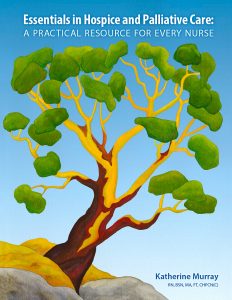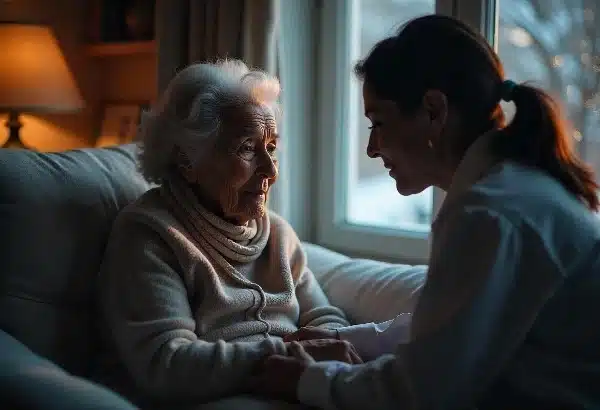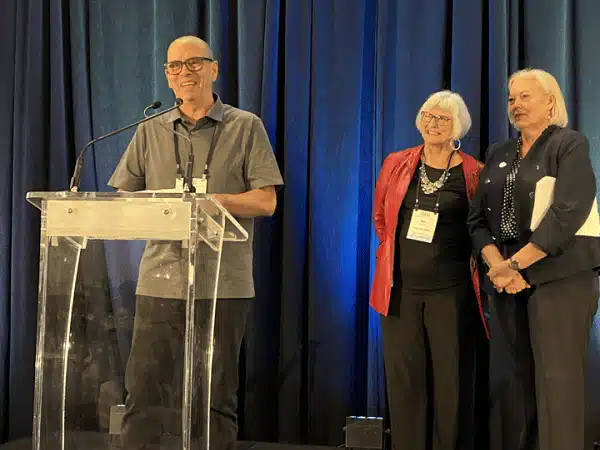A bunch of years ago I met with a group of HPC leaders several times over a number of months. Each month George Eisler from the BC Academic Health Counsel, would ask the question, “How do we prepare the workforce for the coming tsunami of dying?” At the end of the series of meetings a project was developed for educating physicians and medical office assistants. As important as that was, I was concerned about the needs of the front line workers, in particular the health care workers and the nurses, who would be providing care for the dying.
My first book, “Essentials in Hospice Palliative Care,” was written for and provided to participants attending workshops on how to provide care for the dying. It was my hope that this book, the “Essentials text” would be a resource to help them to remember and use what we had talked about in the course as they continued in their practice. I eventually realized that it was the best resource available for Health Care Workers,(HCW), that I needed to “get over myself” and that marketing the Essentials text to colleges that were teaching Health Care Workers across the country would assist those students in learning how to provide care for the dying.
By 2013, the Essentials text and companion resources were integrated into the Personal Support Worker program in approximately one hundred colleges located in Ontario, Alberta and British Columbia. I had a contract with a college to supply them with the text for their HCW and their Practical Nurse (PN) programs. Four years had passed since the Essentials in Hospice Palliative Care text was published. So much had changed – it was time to update it and write the next edition.
Before I started writing a new text, I wanted to know if the Essentials text was helping students in their practice and whether they felt better prepared to meet the needs of the dying. I wanted to know what to change to better meet the needs of the students.
I put together a great research team that included Dr. Anne Bruce, Dr. Antoinette Oberg, Elizabeth Causton, Ann-Marie Gilbert and Ted Murray. Through surveys and interviews we heard from Personal Support Worker (aka HCW) students and their educators who were using our resources. In response to the findings I decided to write a new text dedicated specifically to addressing the education needs and learning styles of Health Care Workers.
My goal for the new text was to create a book that was “delicious and digestible.” “Delicious” meaning that the student opened the book and wanted to turn the pages and read. “Digestible” meaning that the students could see themselves in the stories and would think “I can do that!” And my goal for the students was that they would feel more confident, be more competent and be compassionate in providing care for the dying person and their family.
In late 2014 the new text “Integrating a Palliative Approach: Essentials for Personal Support Workers” and companion teaching/ learning resources were born.
With that text complete, I then had to address the learning needs of students in the Practical Nurse program at the college I had the contract with. The new HCW text did not address their learning needs.
The Nursing Text
To write a completely new text for one small group of colleges? While not a great use of time, I felt it was necessary to honour the contract. An equally important motivator was the fact that the scope of Practical Nursing was increasing across the country. I knew that in long term care settings the PNs were often in charge – they were the leaders and they needed to know the basics. I also understood the need for palliative care to be integrated in caring for people with any life-limiting disease, early in the disease process and in all care settings. This content was needed by all nurses, before graduation – and was missing in the nursing curriculum. I also knew that there was no delicious and digestible, practical and pertinent, current and research-based text available. I decided to take on the challenge.
In the early stages I hoped to tweak the PSW text to meet the needs of the nursing students, presuming that they would want the basics and not want too much depth or breadth. I also wanted to help prepare the nurses to meet entry level competencies related to hospice, palliative, and end of life care.
This was the process that created the PN text.
The Competencies
To clarify the scope and depth of the content required for the nursing text, I reviewed and reflected on:
- PN and RN job descriptions in hospice and palliative care settings
- Scope of practice documents
- LPN Inter-Jurisdictional Entry to Practice Competencies 2013
- Canadian Association of Schools of Nursing (CASN) Palliative and End of Life Care Entry-to-Practice Competencies and Indicators for Registered Nurses
- European Association of Palliative Care Core Competencies in Palliative Care
- College of Licensed Practical Nurses of Alberta’s Palliative Care competencies
- Canadian Education Standards for Unregulated Care Providers 2012
- Ontario PSW Program Standard September 2014
I felt it important to write a book that would help prepare nursing students to meet the required competencies while preparing nurses to provide excellent care for the dying person and their family.
Using concepts and keywords from the CASN (define) competencies I began with a mindmap, then linked concepts from the supporting documents. This exercise inspired me to increase the scope and depth of the new nursing text. I talked with nurses in practice, and they affirmed, they needed and wanted more content. I was clear that I was not wanting to write an alternative to the excellent Oxford Textbook of Palliative Nursing (Ferrell and Coyle)!
I identified competencies that were best addressed through independent research and classroom discussion. I determined to provide a solid text for nursing students and an introductory text for nurses wanting to learn about hospice and palliative care.
The Process
If there is something I am expert at, it is connecting incredible people. Over the past two years I hired nurses, clinicians, counsellors, students and educators to research, summarize, write and review. With the additional input of more than a dozen other hospice and palliative care professionals across Canada, the USA and Ireland, the content was enriched.
The Gift
I was honoured to be approached by the College of Licensed Practical Nurses of Alberta (CLPNA) with an offer to help with the book. They donated time from one of their expert nurse consultants, Jeanne Weis, to work with us five hours a week for six months. Jeanne is a Practice, Policy and Research Consultant that is trained as an RN, LPN, palliative nurse, educator, and just completed her Masters Degree. This gift of Jeanne’s time was a message of support and recognition of the value of the work that I was doing. On many occasions I was buoyed up by their belief in the project
Linking with National Resources
In addition to collaborating with CLPNA, I knew it was important to align the text with national resources. I integrated the CHPCA Process of Providing Care which identifies two additional steps that are often missing when we describe the nursing process (read the book to learn more, or visit the CHPCA website) and I was inspired by the domains of care identified by the NHPCO in the USA, and the eight common issues identified by the CHPCA Model to Guide HPC. They served as the inspiration for the eight star image which I used to frame the nurse who is depicted as considering all the common issues that should be addressed when providing care. We also used this image to present the eight different nurses, representing “every nurse” from different backgrounds working in different care settings.

Content focusing on physical symptoms was aligned with Pallium LEAP (Canada) and ELNEC (USA) course materials. Joanne Thompson, (illustrator), drew a lovely image depicting how the text could prepare a nurse to participate in one of these two courses, or would serve as ongoing education to help embed the knowledge acquired at one of these two courses.
Checking the Research
I wanted to know what was new, if anything had changed, if the basics were still the basics, and what was still in question. I wanted to identify the basics of interactions, the most important themes in communication and ways of being with the dying person and the family.
Nursing Issues
I wanted to know what nurses were wrestling with, to understand the fears of nursing students and how they could overcome them. I wanted to know how education could enhance practice, increase confidence and competence and decrease compassion fatigue. I reviewed the literature and I listened to nurses.
Education
I wanted to understand more about learning, learning styles, principles that I might be able to use to enrich the book and increase the likelihood of students enjoying the reading and integrating the principles in practice.
The Writing
As I said earlier, I thought that I could adapt the information from the earlier texts for the PN text. I was greatly mistaken. The writing of this text was the creation of an entirely new document, though it does share content, outline, and focus. I learned once again that teaching, learning and writing is an iterative process. I wrote, rewrote and wrote some more. I got feedback and we turned things upside down and around again. The ongoing feedback from esteemed colleagues was vital to the project. In the acknowledgement section you will read the names of those who contributed in an ongoing manner to the text. This text would not be what it is, without their support.
I had thought to title the text, “Essentials in Hospice and Palliative Care: A Resource for Practical Nurses and a Practical Resource for Registered Nurses.” However, as colleagues reviewed the text, they said, “This is not just for Practical Nurses, this is a text for every nurse who needs to understand hospice and palliative care”. And so, the title became, Essentials in Hospice and Palliative Care: A Practical Resource for Every Nurse.

The Team
Just as the inter-professional team is important in health care, an inter-professional team is essential in book writing and resource development. You can read the acknowledgements to learn more about our team… but I would like to mention just a few here…
Ann-Marie put my words on paper, she helped me to find words to express ideas, critiqued my writing and pulled me back time and time again to focus on the needs of the learner. She wrestled with this content on a daily basis for the past two years.
Joanne Thomson is “our” artist. Joanne is a former nurse and nurse educator as well as being a mighty fine artist. She uses her art to inspire, educate and to develop community. I so appreciate being able to work with an artist who can take concepts that I am trying to explain with words and put them into illustrations.
Sarah Weber edited and repeatedly asked difficult questions about the writing and what was intended.
Greg Glover is the designer who placed the words and images on paper and worked to make them beautiful and engaging.
Support
Ted, my incredible and supportive hubby of 36 years, has supported this project as he supported the development of the text for health care workers. He does whatever needs to be done to get the work done. In 2014 he tried to retire, and he is working as hard as he ever did in his professional work. People look at him and say, “Aren’t you supposed to be slowing down at your age?” and he, like the energizer bunny, keeps on going.
People have asked over the years, “Who pays for the development of your resources? Where do you get funding?” Together, Ted and I have funded the development, knowing that the need for excellent basic resources is there, and hoping that “if we build it, they will come”.
Next Steps
We will now take a breather and then we will develop companion learning resources, including student learning activities as well as PowerPoint presentations to assist educators and decrease the burden of preparation for educators. We will also be meeting with nurses, educators and students.
Please have a look at the “sneak preview” of the text. If you think it looks like a good resource, please forward to nurses, students and educators. If you have ideas or want to talk with us about integrating the resources in your program and how we might be able to help you, please contact me.
In Closing
This is the short story of how Essentials in Hospice and Palliative Care: A Practical Resource for Every Nurse came to be. On Monday the first shipment is due to arrive. I truly do hope that it will be a wonderful resource for every nurse.
Please email me with your thoughts about this blog posting… I would love to hear from you.








